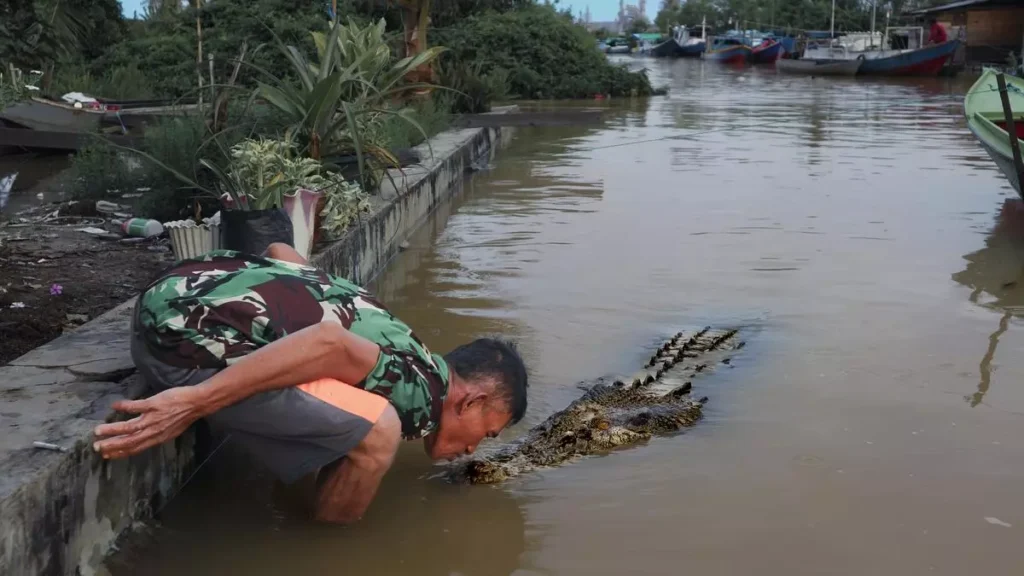In a region where human-wildlife conflicts occur frequently, the relationship offers a rare insight into what is possible when habitats are respected.
Indonesia, renowned for its rich biodiversity, faces challenges in preserving its unique species, including the Sumatran tiger, Javan rhinoceros, Sumatran elephant, proboscis monkey, and critically endangered orangutan. Recently, the crocodile population has come under threat due to habitat loss, illegal wildlife trade, and human encroachment. A notable incident in Sorong, Papua, where 292 crocodiles were killed, sparked debate on human-wildlife conflict. These conflicts arise when human activities encroach on wildlife habitats, posing risks to both humans and animals. As apex predators, crocodiles are frequently involved in such conflicts.
A saline water crocodile from east Kalimantan, a symbol of Indonesia’s rich biodiversity, found in lush mangroves and coastal waters, these apex predators play a vital role in the region’s delicate ecosystem. East Kalimantan’s wildlife is a testimony to the beauty and resilience of nature.
| Photo Credit:
Anil T Prabhakar
Saltwater crocodiles inhabit various Indonesian regions, including Papua, Sulawesi, and Sumatra, as well as South Sumatra, Jambi, North Sumatra, Aceh, the Mentawai Islands, and Kalimantan. Human-crocodile conflicts in these areas stem from habitat destruction and deforestation. Kalimantan, the Indonesian portion of Borneo, comprises five provinces. In East Kalimantan, attacks have been reported along coastal rivers such as the Sangatta, Santan, and Sesumpu, as well as in Nunukan near the Malaysian border. The Mahakam River Delta may harbour a healthy crocodile population, with large specimens observed as far upstream as the Belayan River.
The 24-year-old crocodile’s eyes have a striking detail. Crocodile’s eyes have evolved over 200 million years, making them one of the most advanced visual systems on the planet.
| Photo Credit:
Anil T Prabhakar
Limited data exist on crocodile presence in South Kalimantan, though other species have been sighted in its wetlands. In Central Kalimantan, attacks have been reported on the Mentaya River south of Sampit, and surveys confirm their presence in Tanjung Puting National Park. In West Kalimantan, saltwater crocodiles have been found nearly 1,000 km up the Kapuas River at Putussibau, at Muara Kendawangan south of Ketapang, and in the Kakap River, where recent attacks occurred. Despite these conflicts, positive human-wildlife relationships also emerge.
One such relationship is that of Pak Ambo, a fisherman from East Kalimantan, and a crocodile named Riska. Living in the mangrove forests near Guntung Village, Riska has formed an unusual bond with Ambo over 23 years.
Human-wildlife conflict often puts these creatures at risk. In Indonesia, it is not uncommon to hear news of crocodile attacks, followed by villagers retaliating by killing the crocodiles.
| Photo Credit:
Anil T Prabhakar
I have worked in conservation photography for years. When I learned about Ambo and Riska, I visited him to witness this remarkable connection. Originally from Sulawesi, Ambo moved to East Kalimantan as a young man. While fishing in the mangrove forest, he encountered a crocodile hatchling that followed him. Over time, he began feeding the young crocodile, fostering a unique relationship.
Pak Ambo’s home is Guntung, a small village in Bontang, East Kalimantan. The saltwater crocodile habitat lies about 2 kilometres from his house. His home is located near a narrow water canal that flows towards an inlet. This channel serves as the only water route to reach the mangrove forest, where Riska, the crocodile, can be sighted.
| Photo Credit:
Anil T Prabhakar
As the years passed, their bond strengthened. If Ambo missed a fishing trip, Riska would venture through the creek to wait outside his home. Villagers, fascinated by this relationship, began visiting to see it firsthand.
Pak Ambo with Riska, who is basking in the sun. The crocodile’s size and remarkable features serve as a testament to the strength and resilience of these creatures in their natural habitat.
| Photo Credit:
Anil T Prabhakar
Pak Ambo is not a crocodile handler, yet his connection with the now 14-foot crocodile is extraordinary. He named her Riska after dreaming about her. The mangrove forest where she lives is a 15- to 20-minute boat ride from his home. When my friends and I arrived at 8 a.m., Riska was nowhere in sight. Ambo called her name and clapped. Minutes later, she emerged from the riverbank, swam toward our boat, and lingered nearby for 20 minutes before retreating. It was my closest encounter with a wild crocodile—mere centimetres from our boat.
Riska approached the boat after Pak Ambo called her by name and clapped his hands.
| Photo Credit:
Anil T Prabhakar
Riska, about 24 years old, is in her prime. At over 1,000 pounds and 14 feet long, she is an apex predator, thriving in her environment. Crocodiles, known for their resilience, can live over 70 years in captivity. They are ambush predators, relying on powerful jaws and keen instincts. Riska’s size and behavior suggest she enjoys a stable habitat and ample food supply.
Despite her wild nature, Riska has never attacked a human. She occasionally visits the village through the creek during high tide. Though Ambo trusts her, he never swims with her or disturbs her habitat. He respects her as a wild animal, understanding that unpredictability remains a part of nature.
The connection between Pak Ambo and Riska drew attention and became a talking point in Indonesia. It’s a testament to how mutual trust and respect can form between humans and wildlife.
| Photo Credit:
Anil T Prabhakar
Stories like this tell us a lot about the delicate balance between humans and wildlife. Across the world, such relationships inspire awe, reminding us of the deep, often unexpected, connections we share with nature.
Anil T. Prabhakar is a self-taught photographer based in Indonesia for 16 years, known for works featured in major media and over 60 international exhibitions.
Source:https://frontline.thehindu.com/environment/wildlife-photography-human-wildlife-conflicts-crocodiles-indonesia-habitats/article69167509.ece

